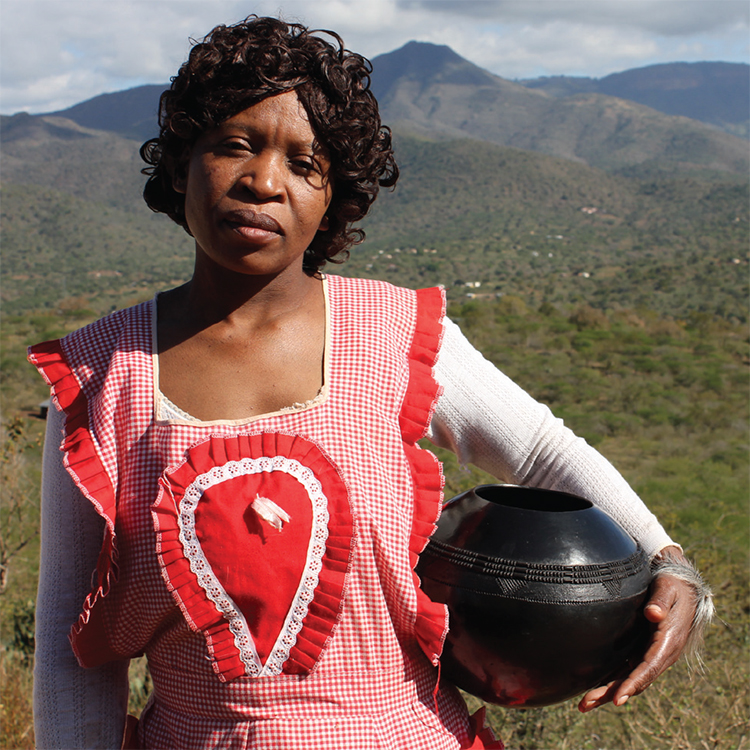Our deepest gratitude goes out to writer and professor Elizabeth Perrill, publisher Robin Stuart-Clark at Print Matters (South Africa) and Diane Pelrine at Indiana University for allowing us to share these incredible publications in cfile.library. Elizabeth Perrill’s 2008 book Ukucwebezela: To Shine is precursory to her 2011 book Zulu Pottery. As of today, both are available in cfile.library.

Perrill, Elizabeth: Zulu Pottery
Western Cape, South Africa: Print Matters, 2011
106 Pages
Of more than 3,000 ethnic groups on the continent of Africa, why do we know the name Zulu so well? In the late 18th century, the Zulu tribe became the most powerful military force in southern Africa, eventually the largest ethnic group, and with the broadest influence. But as might be expected, Zulu glory did not endure; they were defeated by the British army before the end of the 19th century, stripped of their land and made to work labor. Not until 1994, after the end of South African Apartheid, did the Zulus hold their first democratic elections as the independent homeland KwaZulu-Natal. Today KwaZulu-Natal is home to more than 10 million Zulu speakers.
A traditional Zulu pot is a large, burnished, black, wide-mouthed vessel with a surface pattern of raised bumps, brightly colored enamel paint, a necklace of beads (another marker of Zulu identity), and/or intricate geometric sgraffito. They are fired twice in outdoor bonfires. In the two books featured today, Elizabeth Perrill guides our understanding of Zulu history and ceramic craft with a discussion of the process, examples of finished products and examples of the Zulu rituals that go along with the vessels. These books are essential to individuals interested in Zulu culture or craft.
 Perrill, Elizabeth: Ukucwebezela: To Shine
Perrill, Elizabeth: Ukucwebezela: To Shine
Bloomington: University of Indiana, 2008
81 Pages

Mamile Ngema, Ukhamba (beer drinking vessel), 2006. Photo courtesy of Indiana University Art Museum.
In Zulu tradition, pottery is women’s work. It endures via Zulu women passing on skills to their daughters so they can make pots for domestic use and to sell. Such was the case with Nesta Mathom Nala who found international success selling art pottery and whose daughters carry on her craft.
In recent years, Zulu potters have enlivened their decorative surface treatments while maintaining traditional forms, even reviving old functional forms no longer used domestically. This is the case with the ikhanzi (cooking pot), which was ousted in favor of metal cooking pots and the igula (sour milk pot), which was made to hold a substance rarely prepared nowadays. These contemporary Zulu craftspeople are doing their part to preserve Zulu culture by keeping the memory of these forms (and what they represent) alive.

Khonzeni Mantanzi Magwaza sealing an imbiza with cow dung, 2009

However, at least one ceramic form is still part of everyday life in KwaZulu-Natal: the Ukhamba (brewing/ drinking vessel). Perrill defines it as, “A spherical drinking pot approximately ten-to-fifteen inches in diameter with no lip and no foot.” This one, so recognized by Zulus that even contemporary potters have not tinkered with the size of its base and mouth, the ratio of its height to its diameter, and thickness of its walls. After work, men will sit in a circle outside, taking gulps of sorghum beer from the giant pot.
In Ukucwebezala: To Shine, Perrill writes,
“As a group drinking vessel, the ukhamba, the most widely known pot in the contemporary repertoire of Zulu beer vessels, carries connotations of communality and sociability. The passing of an ukhamba from person to person is at the heart of what it can mean to drink utshwala (sorghum beer), emphasizing the interconnectedness of humanity. This idea is also expressed in the saying Umuntu, ngumuntu, ngabantu, ‘A person is a person (or human being) because of (other) people’”

Thembesile Nxumalo with one of her pots, 2011

Work by Jabu Nala, a daughter of Nesta Nala, Ukhamba (beer drinking vessel), 2007
Elizabeth Perrill’s 2008 book Ukucwebezela: To Shine is precursory to her 2011 book Zulu Pottery. As of today, both are available in cfile.library.

The Humanity in shared experience, food, drink, story, governance, is a lesson for All.
What brilliant lessons from our ancestors.
Take heed and practice; inclusion, unity, acceptance, forgiveness.
I’m so inspired by Zulu pottery. I think by now most of the African countries have been inspired by its beautiful designs and beer pots shapes.😊